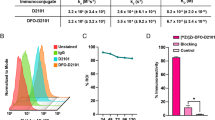Summary
The present studies characterize the binding of [14C]citric acid to synthetic hydroxyapatite (HA) crystals. [14C]Citric acid specifically bound to HA and was dependent upon the concentration of HA in the assay. The binding of [14C]citric acid to HA reached equilibrium within 20 min and remained stable for at least 90 min. Dissociation of bound [14C]citric acid was biphasic in nature since both rapid and more slowly reversible binding components were detected. Saturation experiments also indicated that [14C]citric acid labeled two recognition sites with different affinity (KdH=42 nM and KdL=24,000 nM) and density (BmaxH=161 fmol/μg HA and BmaxL=8.8 pmol/μg HA). Ligand competition experiments revealed that compounds that are known to readily bind bone (e.g., sodium pyrophosphate, methylene diphosphonic acid, etidronate) potently inhibited the binding of [14C]citric acid to HA, whereas compounds known to have poorer affinity for bone (e.g., oxalic acid and GABA) did not. Computer analysis of these inhibition curves revealed specific ligand interactions at two different affinity recognition sites. The present results indicate that [14C]citric acid binds discrete sites on synthetic HA in a fashion consistent with a specific labeling of the bisphosphonate recognition site. Analysis of the binding of [14C]citric acid to HA provides a useful method to further explore the structure activity relationships of novel compounds that have binding affinity for bone.
Similar content being viewed by others
References
Williams G, Sallis JD (1982) Structural factors influencing the ability of compounds to inhibit hydroxyapatite formation. Calcif Tiss Int 34:169–177
Myers HM (1987) Structure-activity relationships (SAR) of hydroxyapatite-binding molecules. Calcif Tiss Int 40:344–348
Fleisch H (1988) Bisphosphonates: a new class of drugs in diseases of bone and calcium metabolism. In: Baker PF (ed) Handbook of experimental pharmacology. Springer-Verlag, Berlin, pp 441–466
Jung A, Bisaz S, Fleisch H (1973) The binding of pyrophosphate and two diphosphonates by hydroxyapatite crystals. Calcif Tiss Res 11:269–280
Fleisch H, Russell RG, Francis MD (1969) Disphosphonates inhibit hydroxyapatite dissolution in vitro and bone resorption in tissue culture in vivo. Science 165: 1262–1264
Francis MD, Russell RG, Fleisch H (1969) Diphosphonates inhibit formation of calcium phosphate crystals in vitro and pathological calcification in vivo. Science 165:1264–1266
Flanagan AM, Chambers TJ (1991) Inhibition of bone resorption by bisphosphonates: interactions between bisphosphonates, osteoclasts and bone. Calcif Tiss Int 49:407–415
Yates AJ, Oreffo ROC, Mayor K, Mundy GR (1991) Inhibition of bone resorption by inorganic phosphate is mediated by both reduced osteoclast formation and decreased activity of mature osteoclasts. J Bone Min Res 6:473–478
Muhlbauer RC, Bauss F, Schenk R, Janner M, Bosies E, Strein K, Fleisch H (1991) BM 21.0955, a potent new bisphosphonate to inhibit bone resorption. J Bone Min Res 9:1003–1011
Ibsen KH, Urist MR (1967) Competition between oxytetracycline and citrate for binding sites on hydroxyapatite crystals. Calcif Tiss Res 1:243–245
Thomann JM, Voegel JC, Gramain PH (1990) Kinetics of dissolution of calcium hydroxyapatite powder. III: pH and sample conditioning effects. Calcif Tiss Int 46:121–129
Williams M, Jarvis MF (1989) Biochemical approaches to drug discovery and characterization. In: Clarke CR, Moos WH (eds) Modern drug discovery technologies. VCH/Ellis Harwood, pp 129–166
Cuatrecasas P, Hollenberg MD (1975) Binding of insulin and other hormones to non-receptor materials: saturability, specificity and apparent negative cooperativity. Biochem Biophys Res Comm 62:31–41
McPherson GA (1989) A mathematical approach to receptor characterization. In: Williams M, Glennon RA, Timmermans PBMWM (eds) Receptor pharmacology and function. Marcel Dekker, New York, pp 47–85
Hay DI, Moreno EC (1979) Differential adsorption and chemical affinities of proteins for apatitic surfaces. J Dent Res 58:930–940
Moreno EC, Kresak M, Hay DI (1984) Adsorption of molecules of biological interest onto hydroxyapatite. Calcif Tiss Int 36:48–59
De Lean A, Hancock AA, Lefkowitz RJ (1982) Validation and statistical analysis of a computer modeling method for quantitative analysis of radioligand binding data for mixtures of pharmacological receptor subtypes. Mol Pharmacol 21:5–16
Abramson SN, McGonigle P, Molinoff PB (1987) Evaluation of models for analysis of radioligand binding data. Mol Pharmacol 31:103–111
Myers HM, Tochon-Danguy HJ, Baud CA (1983) IR absorption spectrophotometric analysis of the complex formed by tetracycline and synthetic hydroxyapatite. Calcif Tiss Int 35:745–749
Misra DN (1991) Adsorption and orientation of tetracycline on hydroxyapatite. Calcif Tiss Int 48:362–367
Sato M, Grasser W, Endo N, Akins R, Simmons H, Thompson DD, Golub E, Rodan GA (1991) Bisphosphonate action: alendronate localization in rat bone and effects on osteoclast ultrastructure. J Clin Invest 88:2095–2105
Author information
Authors and Affiliations
Rights and permissions
About this article
Cite this article
Jarvis, M.F., Burns, C.J., Pauls, H.W. et al. Characterization of the bisphosphonate recognition site on hydroxyapatite using radioligand binding techniques with [14C]citric acid. Calcif Tissue Int 52, 372–377 (1993). https://doi.org/10.1007/BF00310202
Received:
Revised:
Issue Date:
DOI: https://doi.org/10.1007/BF00310202




